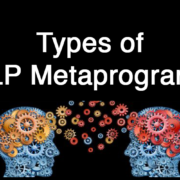Types of NLP Metaprograms
In the last blog, we learnt about NLP Metaprograms. Here, we will explore the different types of Metaprograms in NLP that will prove beneficial to you in the long run. So, are you ready?
While I can’t put forward all the different types of NLP Metaprograms out there in NLP, here are a few mentioned below:
- Towards and Away From. Some people prefer to move towards pleasure, while others prefer to move away from pain.
- Options and Procedures. Some people like to make up things as they go along, while others prefer a routine.
- In-Time and Thru-Time. Some people prefer to be “in the moment” and fully engaged, while others are planning their next moves and future.
- Internal Frame of Reference and External Frame of Reference. Some people prefer judgments based on their own frame of reference, while others prefer to make judgments based on other people’s frame of reference.
- Self and Others. Some people are more self-centered while others are more other directed.
- Detail and Global. Some people prefer the details, while others prefer a map of the bigger picture.
- Feeling and Thinking. Some people prefer to feel their way through things and rely on intuition, while others prefer to think their way through things.
- Sameness and Difference. Some people easily see how things are the same, while others more easily see how things are different.
When you’re selling a product
If you’re selling a product, you can promote in two ways, by what it does or by what it doesn’t do. You can sell by stressing that they’re fast, sleek, comfortable or you can emphasize that they don’t use much gas, don’t cost much to maintain and are particularly safe in crashes. The strategy you should use depends entirely upon the strategy of the person you’re dealing with.
Ask someone else how he knows when he’s done a good job.
For some people, the proof comes from the outside. The boss pats you on the back and says your work was great. You get a raise. You win a big award. Your work is noticed and applauded by your peers. When you get that sort of external approval, you know your work is good. That’s an external frame of reference. For others, the proof comes from inside. They ‘just know inside’ when they’ve done well.
Working Style
Everyone has his own strategy for work. Some people are not happy unless they’re independent. They have great difficulty working closely with other people and can’t work well under a great deal of supervision. They have to run their own show. Others function best as a part of a group. We call their strategy a cooperative one. They want to share responsibility for any task they take on. Still others have a proximity strategy, which is somewhere in between. They prefer to work with other people while maintaining a sole responsibility for a task. They’re in charge but not alone.
By understanding this pattern, you can figure out where your most enjoyable work environments would be.
If you ever give a compliment and it seems like somebody doesn’t believe you, it might be because they are using an internal frame of reference. You also can check this in yourself. For example, do you put more stock in how you rate your performance or do you look to feedback from others? Think about it.
Over to you
I have shared few of the NLP Metaprograms with you. What do you think? By reading up on these different types of NLP Metaprograms, you can understand how you can deal with people around you or at work more effectively and efficiently. We cover more on these in our NLP programs. Have a look at our upcoming programs or submit your queries here. And let me know how you would like to use NLP to live life better.



